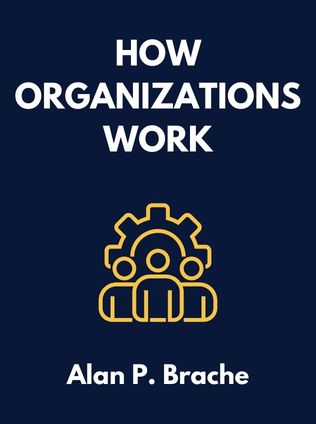
How Organizations Work
Taking a Holistic Approach to Enterprise Health
By Alan P. Brache
Published 01/2002
About the Author
Alan P. Brache is a partner and executive vice president of the training and consulting firm Kepner-Tregoe, Inc. He is an expert in organizational development and performance improvement. Brache has extensive experience in helping organizations identify and address their operational and strategic challenges. His book "How Organizations Work: Taking a Holistic Approach to Enterprise Health" provides a comprehensive framework for understanding and improving the overall health of an organization.
Main Idea
The main idea of "How Organizations Work" is that organizations must be viewed and managed as holistic systems, where all parts are interconnected. This holistic approach considers various internal and external variables that influence organizational success. By addressing these variables in an integrated manner, managers can achieve sustained organizational health and performance.
Table of Contents
- The Parts of an Organization
- Understanding the External Business Environment
- Leading the Enterprise
- Creating Strategic Alignment
- (Re)Designing Business Processes
- Setting Goals and Measuring Progress
- Reframing Culture
- Managing Human Capabilities
- Leveraging Information and Knowledge
- Redesigning the Organizational Structure
- Putting It All Together
The Parts of an Organization
Organizations consist of various interconnected variables: external, structural, human, and combined structural-human. These variables include the external business environment, business processes, goals, information management, organizational structure, leadership, culture, and human capabilities. To achieve organizational wellness, all these parts must work together harmoniously.
"Successful managers of healthy organizations understand that these variables must be treated regularly and holistically to effect change and improve performance." – Alan P. Brache
External Variables
The external business environment encompasses the context in which an organization operates, including the industry value chain, market dynamics, competitors, regulatory landscape, and economic conditions. Understanding these factors is crucial for aligning internal strategies with external opportunities and threats.
"Before focusing on your internal variables, you must first assess and manage these external variables." – Alan P. Brache
Understanding the External Business Environment
Good organizational health starts with understanding the external environment. This includes identifying the industry value chain, current and potential markets, customers' needs, suppliers, and competitors. Monitoring these external factors helps in designing effective strategies and addressing potential threats and opportunities.
"Monitor industry, competitor, technological, legislative, and economic trends to determine future external threats and opportunities." – Alan P. Brache
- Identifying your current and potential markets and customers.
- Assessing your suppliers and their influence on your efficiency.
- Monitoring industry trends to inform strategic decisions.
Leading the Enterprise
Leadership is pivotal in setting the organization's direction and motivating people. Effective leadership aligns with the organization’s strategy, culture, and operational goals. It involves identifying leadership gaps, developing leadership talent, and fostering a motivating environment.
"Leadership is 'first among equals' and required for development and implementation of all the other components." – Alan P. Brache
Addressing Leadership Gaps
- Identifying areas where leadership is most needed.
- Defining current leadership profiles and identifying gaps.
- Establishing clear expectations and consequences for executives.
Creating Strategic Alignment
Strategy involves making choices that determine the nature and direction of an organization. Strategic alignment ensures that the organization’s structure, processes, and resources support its strategic objectives. This alignment requires continuous monitoring and adjustments.
Sign up for FREE and get access to 1,400+ books summaries.
You May Also Like
Rich Dad Poor Dad
What the Rich Teach Their Kids About Money - That the Poor and Middle Class Do Not!
By Robert T. KiyosakiFreakonomics
A Rogue Economist Explores the Hidden Side of Everything
By Steven D. Levitt and Stephen J. DubnerThe Lean Startup
How Today's Entrepreneurs Use Continuous Innovation to Create Radically Successful Businesses
By Eric RiesWho Moved My Cheese?
An Amazing Way to Deal with Change in Your Work and in Your Life
By Spencer Johnson, M.D.Factfulness
Ten Reasons We're Wrong About the World – and Why Things Are Better Than You Think
By Hans RoslingMake Your Bed
Little Things That Can Change Your Life...And Maybe the World
By William H. McRaven



















